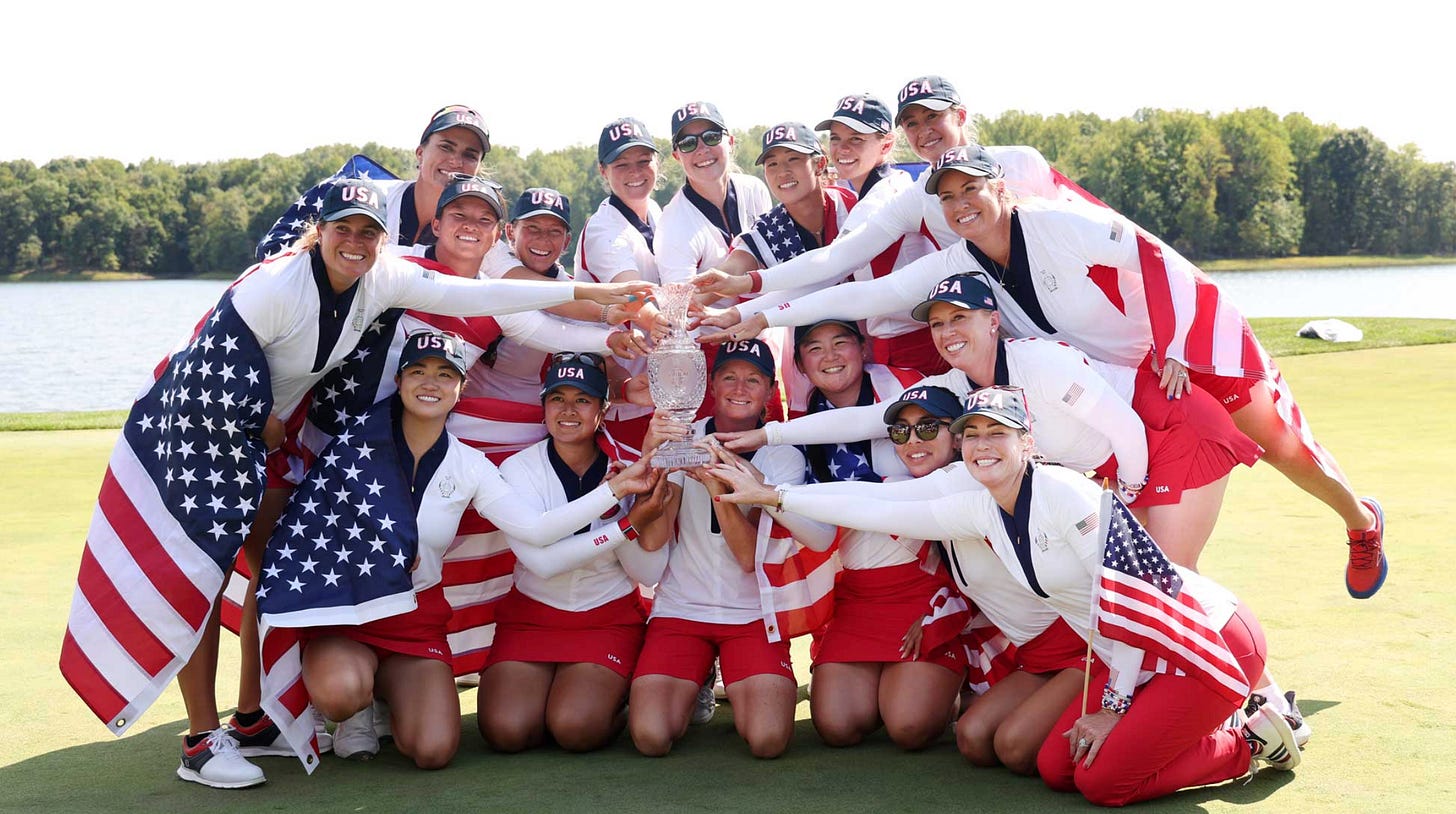Weekend Wrap: U.S. Wins Back Solheim Cup, Rasmus Takes Down Royalty In Newcastle
Europe stages Sunday comeback but Pettersen's decisions backfire. Plus, Tiger Woods announces another back surgery.
Another cup, another classic. Unless you were one of the thousands trying to catch a shuttle.
The 2024 Solheim Cup delivered the glorious range of dramatics that we’ve become accustomed to spoiled-by in team events: brilliant shots under the gun, weird decisions (by the losing Captain), embarrassing four-ball pace of play, a cringeworthy caddie display (not their fault), a former President adding to the first tee buzz, an LPGA display of logistics ineptitude for the ages leading to Friday morning’s funereal first tee, and, after a struggle to get stories straight about what went wrong, an apology from the LPGA Tour Commissioner.
Did I mention there was incredible golf in between all the madness?
In spite of all the weirdness, the United States team Captained by Stacy Lewis arrived at Robert Trent Jones Golf Club only a year removed from a heartbreaking loss in Spain and this time dominated the first two days, before watching Europe close with a strong singles performance to tighten up the final score, 15½-12½.
The three-point difference gave America its first Solheim Cup victory in seven years and the first Cup win by either team of more than two points since 2017.
Sunday’s thrilling last-minute run by Europe started with Charley Hull’s shocking 6&4 drubbing of Nelly Korda despite the match starting with the duo all square through five holes. And the late tightening of matches to make the final four duels important served to highlight the least-appreciated element of biennial professional matches: 28-points.
The system’s ingeniousness works so well in so many ways. It makes a pre-Sunday singles clinching win nearly impossible. And even with a commanding lead—think Brookline!—usually gives a sense that a few matches can flip the entire thing in that weird way cup matches can turn with a slight shift in scoreboard color. It gives us different mediums for the artists to paint and requires different mentalities in a condensed, ultra-intense three days. It rewards stamina and smarts. So, in other words, obvious it’s not a format devised by the same people behind the 12-or-so iterations of the FedExCup.
Sunday saw America needing just 4½ points out of 12 up for grabs to regain the Cup in what is traditionally USA’s best format. (You know, the whole nation-of-golf-narcissists factor.) Yet even with everything working against the Europeans, including amazing crowds with brilliant spirit and by all accounts a wholesomeness that will be missing in Long Island next fall if the PGA of America insists on selling booze at 7 a.m., the USA’s Solheim victory was not solidified until the fourth-to-last match out. That’s when Lilia Vu earned the win with a brilliant approach shot and tap-in to solidify the key half-point.
Europe’s Sunday hopes came out of the blue thanks to a format in use at the Solheim Cup since 2002. The system of two foursomes and two four-ball matches in the opening sessions—before all players go out in Sunday singles—was lifted entirely from the Ryder Cup where the men’s event went to 28-points in 1979.
Various historical accounts only credit the change to “officials” with an assist from 1977’s total debacle.
After 32 points were available in 1975, the Ryder Cup’s always-losing Great Britain and Ireland side lobbied for a change to reduce the number of chances at futility for matches at Royal Lytham & St Anne’s. Only 20 total points were available, and the scheme to put a dent in America’s dominance was made worse by the strange decision to space tee times by 45 minutes to accommodate television. The resulting idea turned the first day into a foursomes-only session with five matches, followed by a second-day four-ball affair, and then ten singles matches to finish off the biennial meeting.
It did not work.
The USA won its 10th straight Ryder Cup by five points, causing the stiff upper lips to cave and fast-tracking the decision to welcome all of continental Europe to the proceedings. Or, to put it another way, find a spot for that ringer of all ringers, Severiano Ballesteros.
The format decision-makers, who should get a spot in the World Golf Hall of Fame and the Format Engineering HOF, set the 1979 matches at The Greenbrier with eight foursomes, eight four-balls, and 12 singles. Cup history was forever changed.
Since then, the perfect 28-point structure has put Captains in delightfully uncomfortable positions of deciding who to play and who to bench. The sweet spot of cup formats has provided us with just the idyllic amount of golf, but not such an excess that performances are watered down by too many meaningless matches. And no matter how well a team plays, there is always just enough room for a comeback.
Whoever those visionaries were and however they concocted the format—free of the proselytizing analytics gang telling them they’re wrong!—found a dreamy sweet spot in 1979 that’s led 21-straight Ryder Cup matches to be played that way. No change is expected in 2025 at Bethpage.
After sorting out how to get fans to and from the course and asking their television partners to do a better job, the LPGA and LET leadership would be wise to stick with what is working for the next matches at Bernardus Golf Cromvoirt, North Brabant, Netherlands, September 7−13, 2026.
The Solheim Cup started smaller and toyed with slight variations before wisely settling on the 28-point sweet spot:
In addition to making runaways difficult, the format has always found a way to make those grim-looking, cart-driving “Captains” appear one of two ways: either as a descendant of Einstein who masterfully pulled all the proper strings, or as a total rube incapable of setting an alarm clock, much less capable of picking out a decent uniform or filling out a sensible lineup card.
Another fun twist of the 28-point sweet spot: the quick turnaround between sessions tends to be another artfully devious component of the matches. This week, as evidenced this time by Europe’s Pettersen choosing to send out Linn Grant four times (0-4) while benching match play force Leona Maguire for all but two sessions.
Coming into the 2024 matches, Maguire held a 7-2-1 Solheim Cup record on top of a brilliant Curtis Cup career where she was (A) the youngest player ever to represent GB&I at age 15 in 2010, (B) made three Curtis Cup appearances with two winning teams, and (C) had won six points in those matches to put her on the all-time greatest list for GB&I.
“I felt like I played great golf today,” Maguire said after her 4&3 singles win. “I feel like I’ve been playing really great golf all week in practice, and it was a bitter pill to swallow to be sat out for as many sessions as I was, but I thought I got a point to prove today, and I love the Solheim Cup.”
“She didn’t give much reason, to be honest,” Maguire said of her Captain’s decision. “The feeling I got was that I was a little bit too short and didn’t make enough birdies, but I think proved today there’s more than one way to skin a cat, and I think I made plenty of birdies today. Captain’s decision. I’m a team player, and all I could do today was come out and win my point, and that’s what I did.”
Meanwhile, Team USA’s Lewis appeared to learn from last year’s matches in Spain. Other than the questionable call to select the “retiring” Lexi Thompson (1-3-0), the intense Lewis exuded a confident calm while pulling all of the right levers in helping her team find a comfort level that does not always surface in a room full of 12 egos used to doing things in their own peculiar ways.
“It was an amazing week from the start,” Lewis said. “From the moment this team was together, they were together. There was no we needed a couple days or anything like that. The vibe in the team room was amazing, the way they got along, the way they support each other. Our group of caddies were off-the-charts keeping the team room loose, making sure everybody had fun, and it showed. It showed in the golf that was played. I'm just so proud of them. I'm proud that they get this moment where they get to celebrate tonight and win this Cup.”
A well-deserved celebration. And another wild week where all involved drove home the sweetness of a 28-point gathering of great golfers.
Other notes from the matches:
Four U.S. players went undefeated: Rose Zhang (4-0-0), Megan Khang (3-0-0), Lauren Coughlin (3-0-1) and Andrea Lee (2-0-1)
It was just the second time that a pair of Americans went 3-0-0 or better in one Solheim Cup. In 1994, both Dottie Pepper and Brandie Burton finished 3-0-0.
This is the second consecutive Solheim Cup that Megan Khang has gone undefeated, making her the fifth player to go undefeated in back-to-back Solheim Cups, joining Cristie Kerr (2015, 2017), Lexi Thompson (2015, 2017), Morgan Pressel (2009, 2011) and Carin Koch (2000, 2002)
Nelly Korda was in the first group out in four sessions to become the first player to play in the first match of four different sessions in one Solheim Cup.
Charley Hull’s 6-and-4 victory is her largest victory in her Solheim Cup career; her next closest was a 5-and-4 victory over Creamer in 2013
Leona Maguire played just two sessions including a 4&3 win in singles. She played in five sessions in both the 2021 and 2023 competitions.
Lauren Coughlin finished this Solheim Cup with a record of 3-0-1, earning 3.5 points, tying the record for most points by a Solheim Cup rookie,
Sunday’s singles results:
Sunday highlights:
Rasmus (65) Continues Denmark’s Irish Open Success
We’ve seen this movie too many times.











